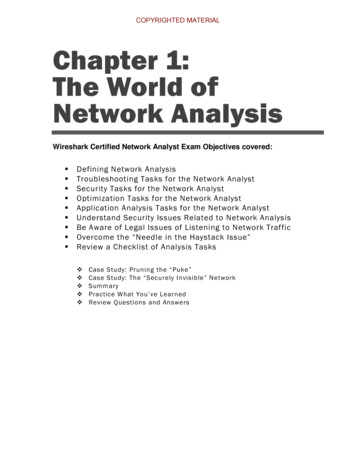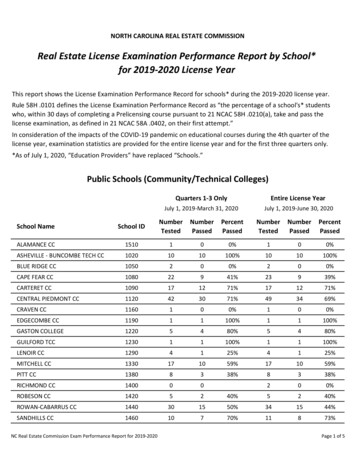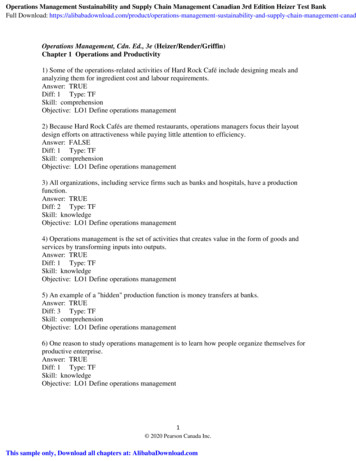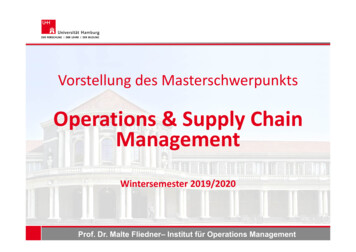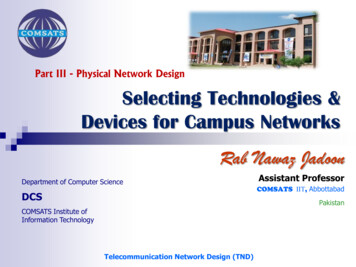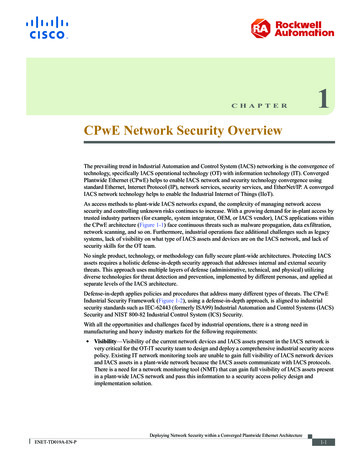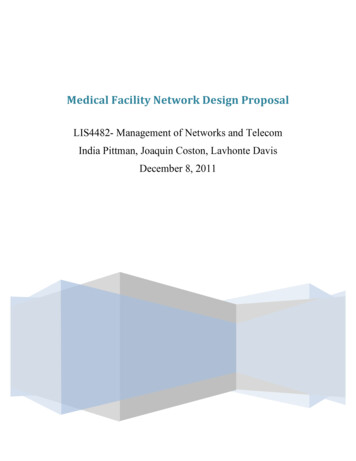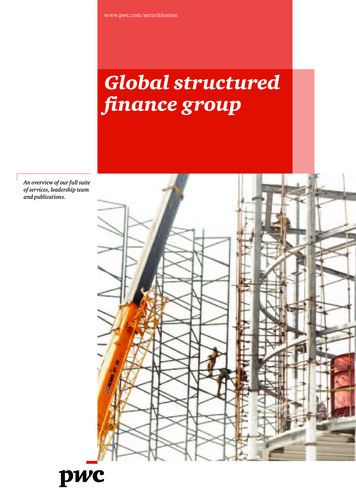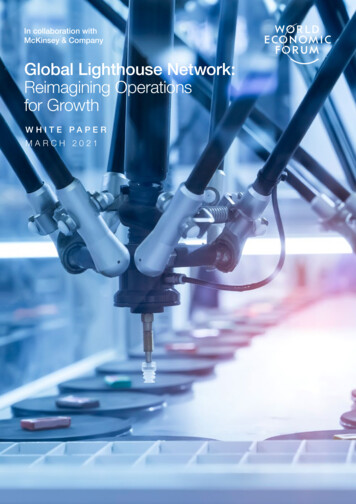
Transcription
In collaboration withMcKinsey & CompanyGlobal Lighthouse Network:Reimagining Operationsfor GrowthWHITE PAPERMARCH 2021
Images: Getty imagesContentsForeword3Executive summary41 Catch the digital shift: The Global Lighthouse Network expands51.1 New lighthouses bring diversity61.2 Lighthouses are deploying a variety of use cases91.3 Lighthouses are role models, driving impact beyond productivity2 Global disruptions trigger unique growth opportunities13142.1 Aftershocks will continue to resonate152.2 Lighthouses show the way ahead153 Lighthouses drive sustainable growth163.1 Innovating business models183.2 Unlocking capacity203.3 Realizing sustainable growth224 Taking Fourth Industrial Revolution innovations to scale264.1 Embracing agility to scale284.2 Investing in workforce development325 Call to action: Extend the light further345.1 Extending the light’s reach355.2 Inspiring other companies striving to deploy Fourth IndustrialRevolution technologies365.3 A call for applications36Contributors37 2021 World Economic Forum. All rightsreserved. No part of this publication maybe reproduced or transmitted in any formor by any means, including photocopyingand recording, or by any informationstorage and retrieval system.Global Lighthouse Network: Reimagining Operations for Growth2
ForewordFrancisco BettiHead of Shaping the Futureof Advanced Manufacturingand Production, WorldEconomic ForumEnno de BoerPartner, McKinsey& Company, USAThe Fourth Industrial Revolution is accelerating as acombination of forces that include global disruptionsand instabilities, supply chain breakdowns andheightened customer demand for digital-firstexperiences. Amid the challenges that these forcesimpose, leading manufacturers are revising theirgrowth strategies, which can serve as beaconsfor others. In many respects, the Fourth IndustrialRevolution is now building upon the achievementsof the past decade, when organizations soughtto improve productivity and minimize cost. But intoday’s increasingly complex environment in whichcustomers demand one-to-one, personalizedexperiences, productivity improvements are tablestakes; the ongoing revolution demands thatcompanies achieve growth beyond productivity toremain competitive.Lighthouses have always held a storied place inthe history of maritime tradition. These aids tonavigation have served as guides and beacons,ensuring the access so crucial to commercialand industrial growth in untapped territory.Their powerful beams pierce the densest fog,enabling passage and empowering progress.When the World Economic Forum began theGlobal Lighthouse Network initiative in 2018 incollaboration with McKinsey & Company, leadingedge manufacturers were illuminating excitingpossibilities that lay ahead for the future of industry.To be sure, though, in the wake of global marketdisruption certainly akin to the stormiest of seas, thelighthouse is now an even more compelling image.Recent global events are changing the very natureof navigation, and powerful beacons are moreessential than ever. The fog is getting thicker andonly the brightest lights can shine through.This is a time of unparalleled industrytransformation; the future belongs to thosecompanies willing to embrace disruptionand capture new opportunities. Ever moremanufacturing companies are showing that itis possible to unlock unprecedented capacity,realize entirely new revenue streams and gainmarket share. Workers are finding that newskills can expand capabilities and the chanceto collaborate in new ways using state-of-theart technology. Consumers, who are driving themarket transformation towards rapidly deliveredtailored products, are finding that their preferencesare being met by innovative competitors in thisredefined marketplace.It is companies like this that comprise the GlobalLighthouse Network: organizations with thecourage to invest in new ideas, new approachesand altogether new methods that are collectivelytransforming the very nature of operations. Despitegrowing complexities and disruptions, thesecompanies continue to show signs of sustainedstrength, keeping the momentum on profit whileremaining responsible corporate citizens. They arerealizing productivity improvements, gaining marketshare, redefining customer centricity and ushering ina cleaner future in which boosted productivity andsustainability measures are not mutually exclusivebut intrinsically intertwined.These pioneering companies stand as beaconsand leaders. Not only are they surviving; they arethriving as they engage the full power of the FourthIndustrial Revolution to drive growth in ways andat levels unseen before. These companies makeclear that growth is possible with little or no capitalexpenditure, proving false the notion that FourthIndustrial Revolution investment is fruitless. Theyhave written a new growth narrative, with digitalas the pen. Whether ahead of the digital curveor lagging behind, no company is immune to thedigital revolution that COVID-19 is accelerating.Organizations unwilling or unable to respond quicklyface perilous waters indeed.Today’s disruptions, despite their challenges, area powerful invitation to re-envision growth. Thelighthouse companies described in this White Paperhave responded, and they illuminate the future ofmanufacturing – indeed, of industry writ large. Theyare the leaders, and their ranks are growing to forma dynamic collaborative. Read on, learn about theirstories and imagine a future in which this networkof beacons continues to grow. After all, their lightis both an inspiration and an invitation. There isstrength in numbers: as the Global LighthouseNetwork grows, the collective light grows brighter,reaching further to an expansive future.Global Lighthouse Network: Reimagining Operations for Growth3
Executive summaryLighthousesare drivingbusiness-modelinnovation throughFourth IndustrialRevolutiontechnologies, andushering in newlevels of customercentric value.Digital innovation is no longer optional. Globaldisruptions and instabilities impose a pressing needand opportunity for quantitative and qualitativegrowth amid shifts in supply, demand andcustomer expectations for digital-first experiences.Companies must find pathways to extend valuethrough novel customer experiences to remaincompetitive; indeed, scalable technology thatsupports business goals is a requirement tobecome an industry-leading digital organization.Accordingly, these forerunners are discovering,furthermore, that this growth need not come at theexpense of environmental responsibility – in otherwords, growth (including higher productivity) andeco-efficiency are not mutually exclusive. In fact, theopposite is taking place: productivity improvementsoften drive resource efficiency gains and are tied toenvironmentally-conscious impact. This conveysthe dual benefits of cost-reduction coupled withincreased sustainability.The Global Lighthouse Network welcomes 15 newlighthouses to an inspiring group of organizationsthat exhibit the essential characteristics of theFourth Industrial Revolution. Lighthouses show theway amid these challenges, demonstrating howdigitally infused operations go beyond productivitygains to create a base for sustainable, profitablegrowth. Through efforts that deploy FourthIndustrial Revolution technologies at scale, they arecreating new revenue streams. Their use of flexibleproduction systems yields increased speed tomarket through customizable product development,which is informed by a better understandingof customer demands; meanwhile, it boostsproductivity of both assets and people.Implementing Fourth Industrial Revolutiontechnologies at scale is key to long-term growth.But what is the secret to scaling? The great majorityof companies remain in pilot purgatory, heldback by outdated working modes or insufficientinnovation. How have lighthouses successfullyscaled the Fourth Industrial Revolution? The answeris twofold: agility and workforce development.It is now clear that lighthouses are driving businessmodel innovation through Fourth IndustrialRevolution technologies, and ushering in new levelsof customer-centric value. By shifting to models thatleverage greater transparency into customer needs,advanced companies are implementing new usecases, such as those enabling mass customizationwith unprecedented speed to market. Throughthese efforts, they are positioning themselves atthe forefront of a competitive marketplace wherecustomers are looking for individualized productstailored to specific preferences.While conventional wisdom might presume thiskind of transformation would come at exorbitantcost, lighthouses are showing the opposite. Theyare achieving growth and higher productivity ratesby unlocking capacity through Fourth IndustrialRevolution technologies, with little to no capitalexpenditure. By coupling state-of-the-art digitaltools with flexible production systems, they achievemeasurable growth without the costly physicalfacility expansion and infrastructure investment suchgrowth might have required in the past. Put simply,leading companies are discovering new ways toachieve growth without a larger footprint.First, these companies have fully embraced agileways of working. This has enabled them to scaleFourth Industrial Revolution technologies quicklyacross their production network and value chains.By transforming their operations to maximizeflexibility and adaptability, lighthouses allow forinnovative thinking and dynamic approaches. Thissupports close attunement to shifts in supply,demand and customer expectations.Second, lighthouses take a keen interest inworkforce development. Training, reskilling andupskilling – teaching new skills for future jobs –keeps their workforces prepared and optimizedin a Fourth Industrial Revolution environment.They keep people at the centre of their FourthIndustrial Revolution transformation with a focus oninclusive growth, thus ensuring operators have theopportunity to realize their full potential to build theinnovative, creative future at the heart of reimaginedindustry. This workforce engagement is essentialto successful scaling. Scaling is a team effort, andpeople are the team.The Global Lighthouse Network comprises a steadilyincreasing group of leaders – beacons that caninspire other companies striving to deploy FourthIndustrial Revolution technologies across their entireoperations. By embracing agile working modesto scale across the production network and valuechains, as well as prioritizing workforce developmentfor scaling, lighthouses demonstrate what ispossible as they achieve sustainable growth. Othercompanies willing to make similarly bold, courageousdecisions can become beacons themselves.Global Lighthouse Network: Reimagining Operations for Growth4
1Catch the digital shift:The Global LighthouseNetwork expandsGlobal Lighthouse Network: Reimagining Operations for Growth5
The GlobalLighthouse Networkis a communityof manufacturersusing FourthIndustrial Revolutiontechnologies totransform factories,value chains andbusiness models.Aiming to close the gap between frontrunnersand laggards while accelerating the widespreadadoption of advanced manufacturing technologies,the World Economic Forum, in collaborationwith McKinsey & Company, launched the GlobalLighthouse Network in 2018. The networkcomprises a community of manufacturers showingleadership in using Fourth Industrial Revolution(4IR) technologies to transform factories,value chains and business models to generatecompelling financial, operational and environmentalreturns. The Global Lighthouse Network welcomes15 new lighthouses as of the date of this WhitePaper, bringing the total to 69 lighthouses acrossdifferent industry sectors (Figure 1).Lighthouses are identified through acomprehensive and independent selectionprocess that has assessed more than 1,000companies from various industry sectors acrossthe globe on the bases of objective results anduse cases. Final selection is delegated to anindependent panel of world-leading 4IR experts.Global Lighthouse Network members today areactively engaged on a cross-industry learningjourney that finds its core value in developing andsharing insights on top use cases, roadmaps andorganizational approaches to deploy advancedtechnologies at scale while supporting thetransition to a more human-centred, inclusiveand sustainable future of operations.1.1 New lighthouses bring diversityThe scope and variety of sectors (Figure 2)represented within the Global Lighthouse Network,including among its newest members, makes clearthat the decisions, shifts and strategies that enablecompanies to succeed in scaling 4IR innovationsare relevant in both traditional manufacturing andother sectors. These strategies are not sectorspecific. Whether companies are focused oncustomized consumer goods, advanced electronics,energy production or biopharmaceuticals, they arecommitting to the same principles to succeed inscaling, leading to sustainable growth. Furthermore,because the network represents manufacturinglocations and value chains of all sizes, from plantsexceeding 10,000 employees to others with100 or fewer, it demonstrates that the adoptionof 4IR technologies is critical and achievable formanufacturers large and small.Global Lighthouse Network: Reimagining Operations for Growth6
FIGURE 1Global Lighthouse Network: 69 lighthousesAn expert panel has added 15 new lighthouses, bringing thetotal to 69 lighthouses identified across various industry sectors.65314110723 2433113 1542122529923 24830 33343637 3839251126New lighthouseExisting lighthouse1EricssonElectronics, USA2Procter & GambleConsumer goods, USA3Procter & GambleConsumer goods, France4HenkelConsumer goods, Spain5SiemensIndustrial automation products, Germany6Johnson & Johnson Consumer HealthSelf-care products, Sweden7STAR RefineryOil and gas, Turkey8ReNew PowerRenewable energy, India913Tata SteelSteel products, IndiaWistronElectronics, China1014FoxconnElectronics, ChinaTsingtao BreweryConsumer goods, China1115HP Inc.Electronics, SingaporeBoschAutomotive, China12MideaHome appliances, ChinaNote: Details on previously selected lighthouses are available in World Economic Forum,“Four Durable Shifts for a Great Reset in Manufacturing”, White Paper, 2020.Source: World Economic Forum and McKinsey & Company.Global Lighthouse Network: Reimagining Operations for Growth7
FIGURE 2Global Lighthouse Network: A diverse network in all industry sectorsConsumer packaged goodsAlibabaApparel, ChinaHenkelConsumer goods, GermanyHenkelConsumer goods, SpainProcter & GambleConsumer goods, Czech RepublicProcter & GambleConsumer goods, ChinaProcter & GambleConsumer goods, USAProcter & GambleConsumer goods, FranceTsingtao BreweryConsumer goods, ChinaUnileverConsumer goods, ChinaConsumer goods, United Arab EmiratesUnileverProcess industriesBaoshan Iron & SteelSteel products, ChinaDCP MidstreamOil and gas, USAMODECOil and gas, BrazilPetkimChemicals, TurkeyPetroseaMining, IndonesiaPOSCOSteel products, South KoreaReNew PowerRenewable energy, IndiaSaudi AramcoGas treatment, Saudi ArabiaSaudi AramcoOil and gas, Saudi ArabiaSTAR RefineryOil and gas, TurkeyTata Steel (2 lighthouses)Steel products, IndiaTata SteelSteel products, NetherlandsAdvanced industriesAGCOAgricultural equipment, GermanyArçelikHome appliances, RomaniaBMW GroupAutomotive, GermanyBosch (2 lighthouses)Automotive, ChinaDanfossIndustrial equipment, ChinaEricssonElectronics, USAFast Radius with UPSAdditive manufacturing, USAFord OtosanAutomotive, TurkeyFOTON CumminsAutomotive, ChinaFoxconnElectronics, ChinaFoxconn Industrial InternetElectronics, ChinaGroupe RenaultAutomotive, BrazilGroupe Renault (2 lighthouses)Automotive, FranceHaierAppliances, ChinaHaierHome appliances, ChinaHitachiIndustrial equipment, JapanHP Inc.Electronics, SingaporeInfineonSemiconductors, SingaporeMicronSemiconductors, SingaporeMicronSemiconductors, Taiwan, ChinaMidea (2 lighthouses)Home appliances, ChinaNokiaElectronics, FinlandPhoenix ContactIndustrial automation, GermanyRoldElectrical components, ItalySAIC MaxusAutomotive, ChinaSandvik CoromantIndustrial tools, SwedenSchneider ElectricElectrical components, IndonesiaSchneider ElectricElectrical components, FranceSchneider ElectricElectrical components, USAIndustrial automation products, ChinaSiemensWeichaiIndustrial machinery, ChinaWistronElectronics, ChinaIndustrial automation products, GermanySiemensPharmaceuticals and medical productsBayerDivision pharmaceuticals, ItalyGE HealthcareMedical devices, JapanGSKPharmaceuticals, UKJohnson & JohnsonConsumer HealthSelf-care products, SwedenJohnson & JohnsonDePuy SynthesMedical devices, IrelandJohnson & JohnsonDePuy SynthesMedical devices, ChinaJohnson & Johnson JanssenPharmaceuticals, IrelandJohnson & Johnson Vision CareMedical devices, USANovo NordiskPharmaceuticals, DenmarkZymergenBiotechnology, USASource: World Economic Forum and McKinsey & Company.Global Lighthouse Network: Reimagining Operations for Growth8
1.2 Lighthouses are deploying a variety of use casesLighthouses are deploying 110 use cases. Whilesome focus within the context of individualmanufacturing sites (Figure 3), others focus onFIGURE 3connecting the value chain end to end (E2E) (Figure4). A variety of use cases are also evident in thenewest lighthouses (Figure 5).Lighthouse use cases: Within manufacturing sitesDigitalassembly agementDigital itive manufacturing forprocess toolsAnalytics platform for deviationroot-cause identificationAnalytics platform for remoteproduction optimizationAI-enabled safety managementDigital twin of sustainabilityAI-powered optical inspectionAdvanced industrial internet ofthings (IIoT) process optimizationCost optimization of heavyoperations through sensoranalysisAnalytics platform for yieldmanagement and root-causeanalysisEnergy optimization by predictiveanalyticsDigitally enabled pipeline leakprevention and detectionDigital dashboards to monitoroverall equipment effectivenessperformanceArtificial intelligence (AI)-guidedmachine optimizationAI-powered material handlingsystemAI-powered process controlMachine alarm aggregation,prioritization and analyticsenabled problem-solvingAutomated in-line opticalinspection to replace endproduct manual inspectionsDigital quality auditDigital work instructions andquality functionsDigital recruitment platformtailored to shop floorIIoT real-time energy dataaggregation and reportingdashboardSensor-based data collection forenergy managementDigitally enabled batch releaseCollaborative robotics andautomationCycle time optimization throughbig-data analytics on linesprogrammable logic controllers(PLCs)Digital engineeringPredictive maintenanceaggregating data based onhistorical and sensor dataReal-time pipeline costoptimization based on edgesensorsRemote assistance usingaugmented realityDigital lean tools (e.g. eKanban)Digital twin for flexible productionUnmanned vehicles forinspectionDigital tools to enhance aconnected workforceDigital twin for remote productionoptimizationDigitally enabled man-machinematchingEnterprise manufacturingintelligence system to upgradeoperations managementDigitally enabled flexiblemanufacturingIntegration platform to connectmachine-level data withenterprise softwareDigitally enabled modularproduction configurationReal-time asset performancemonitoring and visualizationDigitally enabled variabletakt timeSensor-based manufacture keyperformance indicator reportingLight-guided assembly sequenceDigitized standard procedures forline operations with integratedworkflowField quality failures aggregation,prioritization and advancedanalytics-enabled problemsolvingInternet of things (IoT)enabled manufacturing qualitymanagementMixed reality glasses to guideoperators in the end-of-lineinspectionQuality improvement bypredictive analyticsScanning to replace and improveperformance for high-costcoordinate measuring machines(CMM)Mixed reality to enable digitaltrainingReal-time locating system(RTLS) for key manufacturingcomponentsSource: World Economic Forum and McKinsey & Company.Global Lighthouse Network: Reimagining Operations for Growth9
FIGURE 4Lighthouses use cases: Connecting the value chain end to endSupply networkconnectivityE2E productdevelopmentE2E planningE2E deliveryCustomerconnectivityAgile buying through pricepredictionAdvanced analytics forperformance management acrossthe idea to marketAdvanced analytics to optimizethe manufacturing anddistribution footprintAsset utilization and yardmanagement for logisticsConnected devices to track andmeasure consumer behavioursBig-data/Al-enabled productdesign and testingAnalytics for dynamic warehouseresource planning and schedulingAvailable to promise (ATP) basedon real-time constraintsConnected devices to track andmeasure product performanceCrowdsourcing and competitionsto develop digital solutionsClosed-loop planningDigital-enabled picking andtransportCustomer analytics enabled byradio frequency identification(RFID)Aggregate demand across E2Esupplier networkAnalytics-driven procurementsupported by spend intelligenceand automated spend cubeAI to accelerate the scaling ofdigital applications across sitesAI-powered contract review fordecision-makingDigital supplier performancemanagementDigitally enabled automaticmaterial call-off systemDigitally enabled negotiationJoint data analytics with originalequipment manufacturer forprocess optimizationPart traceability from uniquedigital tag based on surfacescanningDigital thread implementationthrough product developmentlife cyclesDigital logistics control towerDigital integrated businessplanningDigital track and traceDynamic network optimizationCustomer end-user interface toconfigure and order a product,and track deliveryDynamic delivery optimizationProduct development usingroboticsDynamic production schedulingwith digital twinNo-touch order managementDelivery to customers whereverthey are through new deliverysolutionsRapid outsourced prototypingDynamic simulation forwarehousing designPredictive maintenance in fleetassetsDigital twin of customer systemE2E real-time supply chainvisibility platformRobotics-enabled logisticsexecutionGPS-based map and customerlocationNo-touch master planning(allocation to the plants)Uberization of transportMarket insights generated byadvanced analyticsTesting automationVirtual-reality-supportedprototyping3D printing for rapid designprototyping3D printingPredictive demand forecasting3D simulations/digital twin forproduct design and testingShould-cost modelling to supportmake versus buy decisionsSupplier and materials qualitytrackingSupplier material delivery byeKanbanPredictive inventoryreplenishmentProduction planning optimized byadvanced analyticsMass customization andbusiness-to-consumer onlineorderingOnline communities for customerinsightsSmart/intelligent packagingReal-time inventory management(internal/extremal)Real-time sales and operationsplanningSource: World Economic Forum and McKinsey & Company.Global Lighthouse Network: Reimagining Operations for Growth10
FIGURE 5New lighthouses: Next-generation use casesSiteChange storyUse caseBoschSuzhou, ChinaAs a role model of manufacturing excellencewithin the group, Bosch Suzhou deployed a digitaltransformation strategy in manufacturing andlogistics, reducing manufacturing costs by 15%while improving quality by 10%.Digital shift performance managementImpact8%Direct productivityDigitally enabled automatic material call-off system35%Production stockCustomer end-user interface to configure and order10%Logistics costSmart quality management allocationCycle time and changeover optimization by machine visionEricssonLewisville, USAFaced with increasing demand for 5G radios,Ericsson built a US-based, 5G-enabled digitalnative factory to stay close to its customers.Leveraging agile ways of working and a robust IIoTarchitecture, the team was able to deploy 25 usecases in 12 months and, as a result, increasedoutput per employee by 120%, and reduced leadtime by 75% and inventory by 50%.5G collaborative robotics and automationHenkelMontornès, SpainHP Inc.SingaporeJohnson & JohnsonConsumer HealthHelsingborg, SwedenMideaShunde, ChinaProcter & GambleAmiens, FranceConfronted with fast-growing demand and labourskill scarcity, Foxconn Chengdu adopted mixedreality, artificial intelligence and IoT technologies toincrease labour efficiency by 200% and improveoverall equipment effectiveness by 17%.To drive further improvements in productivity andboost the company’s sustainability, Henkel builton its digital backbone to scale Fourth IndustrialRevolution technologies linking its cyber andphysical systems across the Montornès plant,reducing its costs by 15% and accelerating itstime to market by 30% while improving its carbonfootprint by 10%.Facing an increase in product complexity and labourshortages leading to quality and cost challenges,along with a move at the country level to focuson higher-value manufacturing, HP Singaporeembarked on its Fourth Industrial Revolution journeyto transform its factory from being manual, labourintensive and reactive to being highly digitized,automated and driven by artificial intelligence,improving its manufacturing costs by 20%, and itsproductivity and quality by 70%.In a highly regulated healthcare and fast-movingconsumer goods environment, J&J ConsumerHealth addressed customer needs throughincreased agility using digital twins, robotics andhigh-tech tracking and tracing to enable 7%product volume growth, with 25% acceleratedtime to market and 20% cost of goods soldreduction. It made further investments inconnecting green tech through Fourth IndustrialRevolution technologies to become Johnson& Johnson’s first ever CO2-neutral facility.To expand its e-commerce presence andoverseas market share, Midea invested in digitalprocurement, flexible automation, digital quality,smart logistics and digital sales to improve productcost by 6%, order lead times by 56% and CO2emissions by 9.6%.P&G Amiens, a plant with a steady history oftransforming operations to manufacture newproducts, embraced Fourth Industrial Revolutiontechnologies to accommodate a consistent volumeincrease of 30% over three years through digitaltwin technology as well as digital operationsmanagement and warehouse optimization, leadingto 6% lower inventory levels, 10% improvement inoverall equipment effectiveness, and 40% scrapwaste reduction.Maintenance cost10%Machine productivity120%Output per employee5G robotics-enabled logistics execution65%Manual material handling5G sensor-based data collection for energy management97%CO2 emissionsArtificial-Intelligence-powered optical inspectionDigital twin for remote production optimizationFoxconnChengdu, China6%Digitally enabled man-machine matching5%Throughput8%Efficiency200%Labour productivityArtificial-intelligence-powered optical inspection92%Manual inspectionPredictive maintenance aggregating historical and sensor data17%Overall equipment effectivenessIoT-enabled manufacturing quality management99%Quality alert timeProduction planning optimized by advanced analytics25%InventoryEnergy optimization by predictive analytics10%CO2 emissionsDigital tools to enhance a connected workforce20%Changeover timeArtificial-intelligence-powered process control20%Unscheduled downtimeRobotics-enabled logistics execution16%InventoryDigital track and trace30%Speed to marketAutomated in-line optical inspection70%Labour efficiencyCollaborative robotics and automation10%Manufacturing costReal-time asset performance monitoring and visualization10%Reduction in yield lossAnalytics platform for remote production optimization70%Outgoing qualityAdditive manufacturing (3D printing)40%Lead time3D simulations/digital twin for product design and testing25%Speed to marketCollaborative robotics and automation16%Gross profit improvementSensor-based data collection for energy management18%CO2 emissionsDigital track and trace15%Cost of goods soldDigitally enabled batch release90%Labour costAgile buying through price prediction5%Robotics-enabled logistics execution53%Lead timeArtificial-intelligence-powered optical inspection15%Customer complaintsLights-off logistics40%Loading efficiencyEnd-to-end real-time supply chain visibility platform40%Channel inventoryDigital twin for remote production optimization6%Raw material costInventoryConnecting machine-level data with enterprise software30%Customer complaintsAnalytics for dynamic warehouse resource planning9.8%On-time deliveryDigital engineering25%CapacityAdvanced analytics to optimize logistics40%Packaging materialsGlobal Lighthouse Network: Reimagining Operations for Growth11
SiteChange storyUse caseProcter & GambleLima, USAA shift in consumer trends meant more complexpackaging and an increased number of productsthat had to be outsourced. To reverse the tide,P&G Lima invested in supply chain flexibility,leveraging digital twins, advanced analytics androbotic automation, resulting in an acceleration ofspeed-to-market for new products by a factor 10,an increase in labour productivity by 5% year overyear, and in plant performance that was two timesbetter than competitors in avoiding stock outsduring the year.Digital twin for flexible productionFacing exponential asset growth and risingcompetitiveness from new entrants, ReNew Power,India’s largest renewables company, developedFourth Industrial Revolution technologies, suchas proprietary advanced analytics and machinelearning solutions, to increase the yield of its windand solar assets by 2.2%, reduce downtimeby 31% without incurring any additional capitalexpenditure, and improve employee productivityby 31%.Analytics platform for wind turbine optimizationTo achieve its productivity goals, this siteimplemented a structured lean digital factoryapproach, deploying smart robotics, artificialintelligence-powered process controls andpredictive maintenance algorithms t
First, these companies have fully embraced agile ways of working. This has enabled them to scale Fourth Industrial Revolution technologies quickly across their production network and value chains. By transforming their operations to maximize flexibility and adaptability, lighthouses a
